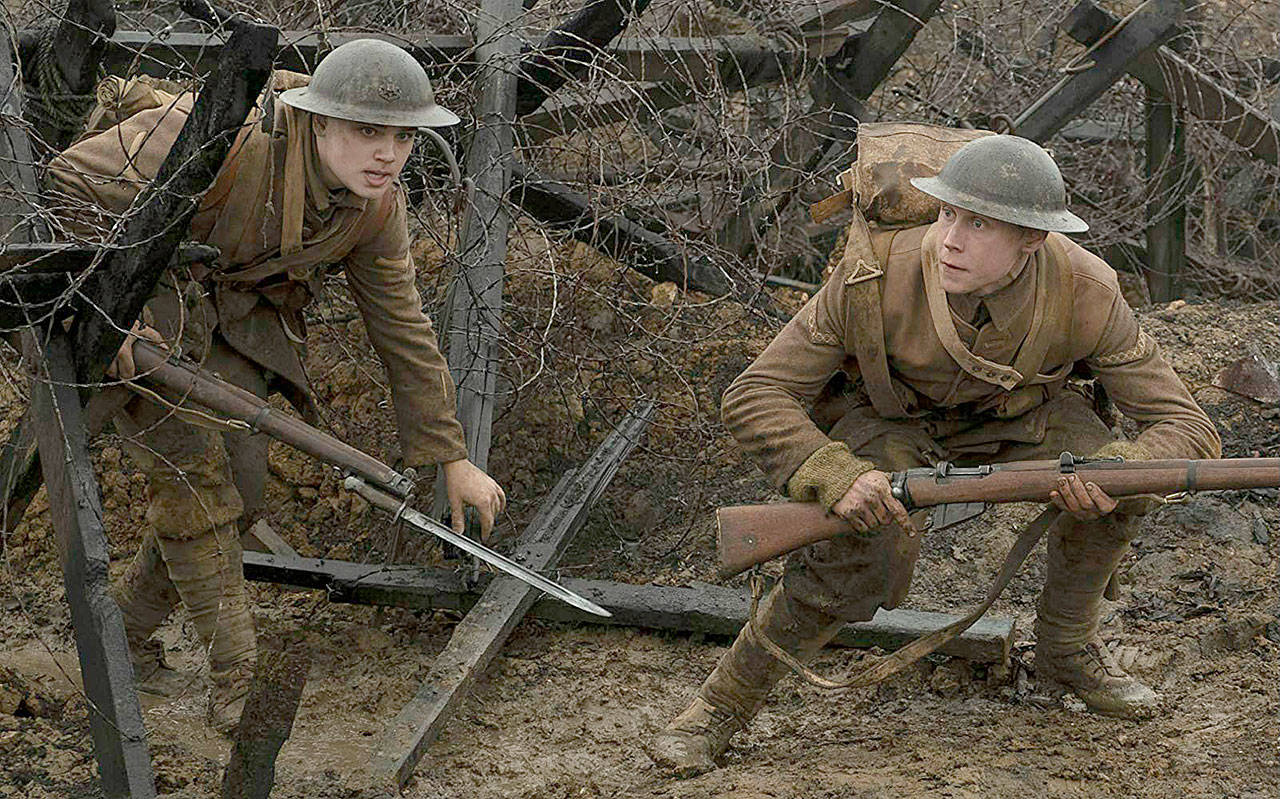Hollywood has been wringing its hands over how to get people into theaters in the age of streaming. “1917” offers a clue.
Part technical stunt, part mission movie, “1917” is nothing if not a spectacle best witnessed on a big screen. On Sunday it won Golden Globe awards for Best Drama and Best Director, and while the Globes are intrinsically silly, the wins do suggest an appetite for a kind of old-fashioned moviegoing experience, albeit one that could not have been made before the digital era.
We’ll get to the technical part later. First, the story: It’s World War I, and two young British corporals receive a delicate, time-sensitive mission. If they don’t deliver a crucial message to an advance unit, hundreds of British soldiers will be massacred in a German counterattack.
The soldiers are Schofield (George MacKay) and Blake (Dean-Charles Chapman, a onetime “Game of Thrones” regular). For the latter, the assignment is personal, as well as critical: His brother is in the unit about to be led into slaughter.
They must cross the desolation of no man’s land — a fetid stew of corpses and booby traps — in order to deliver the message. They have until dawn.
This story should be effective even if executed in a straightforward way. But Oscar-winning director Sam Mendes, who made “American Beauty” and the last couple of James Bond films, has a battle plan for this tale.
Working with the all-universe cinematographer Roger Deakins, Mendes has staged “1917” so that the action appears to be unfolding in two long, unbroken shots. (There’s a very specific interlude at about the two-thirds mark.) The camera glides behind, in front of and alongside our heroes as they cover ground, while digital technology masks the edits.
Yet this isn’t exactly “real time.” Mendes is doing something interesting with the way time (and distance) passes. The mission must take well over the two hours of screen time to achieve their goal, even with the one gap, so our brains adjust accordingly. The fog of war messes with how we experience time going by.
The whole thing is a fascinating movie-watching experiment, although it’s legitimate to ask why “1917” had to be filmed this way. The technique does give us a sense of the dreary slog at the front lines, although at times there’s something mechanical about the effects and the series of death-defying coincidences that unfold like clockwork.
The suspense is undeniable — it’s like watching a silent movie where the heroine is tied to the railroad tracks and the train is chugging away in the distance. Your pulse will pound, even if you’re aware of the manipulations.
Mendes chose well in casting his little-known lead actors. Chapman conveys a cheerful, determined chap, optimistic by nature, while the scarecrow-shaped MacKay is more skeptical, his narrow eyes prepared for the worst.
A few name actors flash by in brief turns along the way: Colin Firth, Benedict Cumberbatch, Mark Strong. As a cynical officer who sends our duo out of the trenches and into No Man’s Land, Andrew Scott (“Fleabag”) gives a brilliant demonstration of how a two-minute performance can leave an indelible impression.
His character is the closest the movie comes to suggesting the absurdity of war itself; you have to go back to a different era (Stanley Kubrick’s unforgettable WWI film “Paths of Glory,” for instance) for that. The characters here do not reason why — they simply do, and sometimes die.
“1917” (3 stars)
Sam Mendes directs this World War I suspense film as though it were unfolding in two long, unbroken shots — a technical marvel that sometimes overshadows the story itself. We follow two British soldiers (George MacKay, Dean-Charles Chapman) as they move through a pulse-pounding mission across No Man’s Land.
Rating: R, for violence
Opening Friday: Alderwood, Alderwood Mall, Cinebarre Mountlake Terrace, Everett Stadium, Galaxy Monroe, Marysville, Stanwood Cinemas, Meridian, Oak Tree, Pacific Place, Seattle 10, Thornton Place Stadium, Woodinville, Oak Harbor Plaza
Talk to us
> Give us your news tips.
> Send us a letter to the editor.
> More Herald contact information.

























